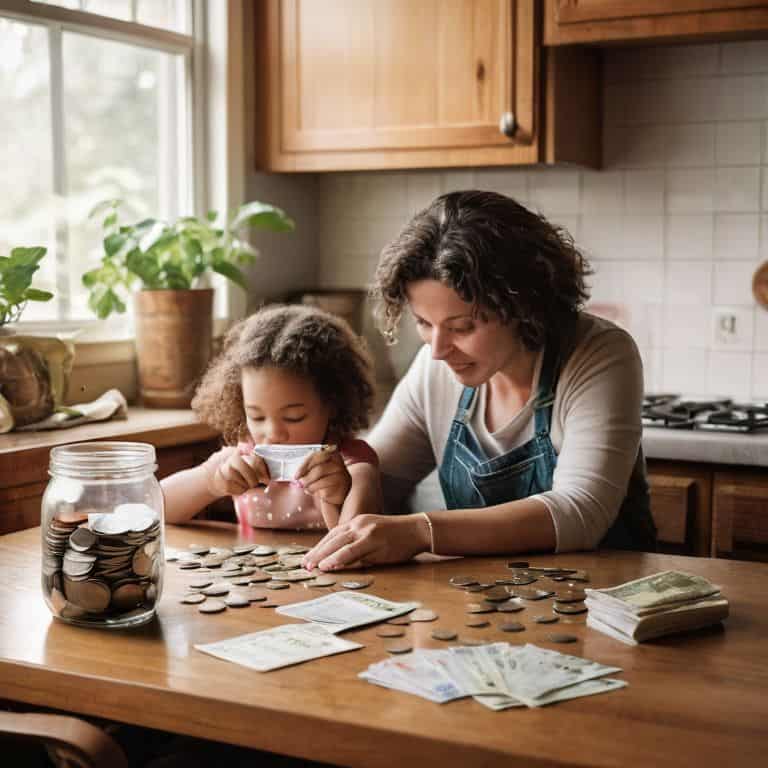I still remember the day my daughter asked me why we couldn’t afford a new bike, and I realized I had been avoiding the conversation about how to teach your kids about money. It was a wake-up call, and I soon discovered that many parents struggle with this topic, often because they believe they need to be financial experts to teach their kids about money. But the truth is, it’s not about being a genius with numbers; it’s about having open and honest conversations about the value of money.
In this article, I’ll share practical advice on how to teach your kids about money, from setting up a simple allowance system to encouraging entrepreneurship. You’ll learn how to create a financially literate child who understands the importance of saving, spending, and giving. My goal is to provide you with a clear plan to reduce your anxiety and increase your confidence when it comes to teaching your kids about money. By the end of this guide, you’ll be equipped with the tools and knowledge to raise mindful money managers who will thrive in today’s economy.
Table of Contents
Guide Overview: What You'll Need

Total Time: 1 hour 15 minutes
Estimated Cost: $0 – $10
Difficulty Level: Easy
Tools Required
- Piggy Bank for demonstration purposes
- Calculator for calculating expenses
Supplies & Materials
- Play Money for practicing transactions
- Allowance Tracker for monitoring progress
Step-by-Step Instructions
- 1. First, start small by having open and honest conversations with your kids about money. Begin with simple concepts, such as the value of saving and the importance of earning money through chores or small jobs. I like to use real-world examples, like saving up for a new bike or toy, to help them understand the concept of delayed gratification.
- 2. Next, introduce your kids to the 50/30/20 rule, where 50% of their money goes towards necessities, 30% towards discretionary spending, and 20% towards saving and giving back. This will help them develop a healthy relationship with money and understand the importance of prioritizing their spending. You can use a clear glass jar or a piggy bank to divide their money into these categories and make it a fun, visual exercise.
- 3. Then, encourage your kids to earn their own money through chores, babysitting, or dog walking. This will help them understand the value of hard work and the concept of earning money. You can also use this opportunity to teach them about taxes and deductions, explaining that a portion of their earnings will go towards supporting their community and country.
- 4. Now, it’s time to talk about budgeting and tracking expenses. Introduce your kids to a simple budgeting app or a spreadsheet where they can track their income and expenses. This will help them develop a habit of mindfulness when it comes to spending and make more informed decisions about their money. You can also use this opportunity to discuss the importance of avoiding impulse purchases and waiting 24 hours before buying something non-essential.
- 5. Fifth, teach your kids about the power of compound interest and the benefits of saving for long-term goals, such as college or a big purchase. You can use a simple example, like saving $100 per month for a year, to demonstrate how their money can grow over time. This will help them develop a long-term perspective and understand the importance of patience and discipline when it comes to saving.
- 6. Next, role-play different real-life scenarios, such as going to the store or eating out, to teach your kids about making smart financial decisions. This will help them develop critical thinking skills and learn how to make choices that align with their values and goals. You can also use this opportunity to discuss the importance of tipping and generosity, explaining that showing appreciation for good service is a key part of being a responsible consumer.
- 7. Finally, make it a game by turning financial literacy into a fun, interactive experience. You can create a mock store or play restaurant where your kids can practice making financial decisions and learn from their mistakes in a low-stakes environment. This will help them develop a positive association with money management and make the learning process more enjoyable and engaging.
Mindful Money Lessons

As I reflect on my own experiences with mindful money lessons, I realize the importance of age appropriate financial lessons. When my kids were young, we started with simple concepts like saving and spending. As they grew older, we introduced more complex ideas like budgeting and investing. I’ve found that teaching kids to budget is crucial in helping them understand the value of money and making smart financial decisions.
One of the most effective ways to encourage kids to develop good financial habits is to discussing needs vs wants with them. This helps them understand that there’s a difference between what they need and what they want. By having open and honest conversations, kids can learn to prioritize their spending and make more informed decisions. I’ve also found that encouraging kids to earn money through chores or small jobs can help them appreciate the value of hard work and the money they earn.
As kids enter their teenage years, it’s essential to introduce them to more advanced financial concepts, such as investing. Introducing investing to teenagers can seem daunting, but it can be a great way to teach them about long-term financial planning and the importance of saving for the future. By starting early and being consistent, parents can help their kids develop healthy financial habits that will last a lifetime.
Budgeting for Kids Made Easy
To make budgeting accessible to kids, I recommend using the “Three Jar Method”. Divide their allowance into three jars: save, spend, and give. This simple system helps them understand the value of allocating their money towards different goals. For younger kids, you can use physical jars, while older kids can use digital tools to track their expenses.
By introducing this method, you’ll help your kids develop a healthy relationship with money and make conscious decisions about how they want to use their resources. As they grow, you can gradually add more complexity to their budgeting, but starting with this basic framework will give them a solid foundation for mindful money management.
Teaching Age Appropriate Finance
When teaching kids about money, it’s essential to consider their age and understanding. For younger ones, it’s about introducing basic concepts like saving and spending. As they grow, you can delve into more complex topics like earning and investing. I’ve found that using real-life examples, like saving for a toy or a short-term goal, helps them grasp these ideas.
For older kids, you can explore more advanced topics, such as budgeting and the value of compound interest. The key is to make it relatable and engaging, using everyday situations to illustrate financial principles. By doing so, you’ll help them develop a healthy relationship with money that will serve them well into adulthood.
Raising Financially Aware Kids: 5 Essential Tips
- Start conversations, not lectures: Talk to your kids about money in a way that feels like a dialogue, not a sermon, and be open to their questions and concerns
- Use real-life examples: Incorporate everyday situations, like grocery shopping or saving for a toy, to teach money management skills in a relatable way
- Make it hands-on: Encourage your kids to earn and manage their own money, whether through chores, a part-time job, or a small business venture
- Lead by example: Show your kids what responsible money habits look like by being mindful of your own spending and saving, and explain your decisions in a way they can understand
- Teach the value of waiting: Help your kids understand that delayed gratification can be a powerful financial tool by encouraging them to save for long-term goals, like college or a big purchase
Key Takeaways for Raising Financially Aware Kids
Start conversations about money early and be open about your own financial experiences to help your kids develop a healthy relationship with money
Teach age-appropriate financial lessons, such as budgeting and saving, using relatable examples and activities to make learning fun and engaging
Lead by example and practice mindful money habits yourself, as kids often learn by observing their parents’ behavior and attitudes towards finances
Raising Financially Aware Children
Teaching your kids about money isn’t about raising little accountants, it’s about giving them the tools to turn their values into priorities, and their priorities into a lifelong journey of financial freedom.
Leo Carter
Empowering the Next Generation

As we’ve explored the world of teaching kids about money, it’s clear that mindful money lessons are key to setting them up for a lifetime of financial freedom. By following the step-by-step guide and incorporating age-appropriate finance into your daily conversations, you’ll be well on your way to raising little entrepreneurs who understand the value of a dollar. Remember, it’s not just about teaching them how to budget, but also about showing them how to make intentional decisions about their money. By doing so, you’ll be giving them a permission slip to spend on what truly matters, and that’s a gift that will last a lifetime.
As you embark on this journey with your kids, I want to leave you with a final thought: financial wellness is a journey, not a destination. It’s okay to make mistakes along the way, and it’s essential to be patient and supportive as your kids navigate their own relationships with money. By working together and focusing on building healthy habits, you’ll not only be teaching them about money, but also about the importance of living below your means and finding true fulfillment in life. So, take a deep breath, be consistent, and trust that the lessons you’re teaching today will have a lasting impact on your kids’ financial futures.
Frequently Asked Questions
How can I make talking about money a regular and comfortable part of our family conversations?
To make talking about money a regular part of your family conversations, start small by sharing your own financial experiences and decisions. Use everyday moments, like grocery shopping or saving for a vacation, to casually discuss money matters. I call this “money mentoring” – it helps normalize financial discussions and sets your kids up for a lifetime of smart money habits.
What are some age-specific activities or games that can help my kids understand basic financial concepts?
For younger kids, try a piggy bank system or a ‘store’ game where they earn and spend play money. As they get older, introduce budgeting apps or simulations, like a mock stock market or a virtual savings challenge. These interactive tools help them grasp financial concepts in a fun, relatable way.
How can I balance teaching my kids the value of saving and responsible spending with also allowing them to make their own financial mistakes and learn from them?
I believe in giving kids the freedom to make some financial mistakes – it’s a valuable learning experience. Set clear guidelines, then gradually give them more autonomy to make choices. This balance between guidance and independence will help them develop a healthy relationship with money, learning from their own decisions and building resilience for life’s financial ups and downs.
